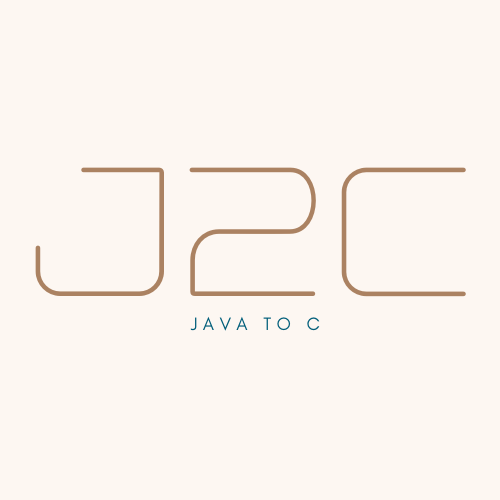In the Spring of 2022, I undertook one of the most challenging and rewarding projects of my academic journey at California State University, Northridge. Enrolled in COMP 430: Language Design and Compilers, I was tasked with not just learning about compilers but building one from scratch. The project, dubbed J2C, was an ambitious endeavor to design a new programming language and implement a complete compiler that translates this language into C code.
Introduction to COMP 430: A World of Language Design
COMP 430 is a course that delves deep into the intricacies of programming language design and compiler implementation. The curriculum covers the theoretical and practical aspects of how programming languages are constructed and how compilers translate high-level code into executable programs. The course emphasizes:
- Examination of language design issues.
- Implementation difficulties associated with various language features.
- Tools and techniques for processing programming languages and building compilers.
Why Java to C?
The idea for J2C was born out of a desire to bridge high-level object-oriented programming concepts with low-level procedural paradigms. Java, with its robust object-oriented features, served as an inspiration for the source language, while C, known for its performance and close-to-hardware operations, was chosen as the target language.
The choice wasn’t arbitrary. It represented an exploration of how complex abstractions could be deconstructed and mapped onto simpler, foundational constructs. This translation from a high-level language to a lower-level one isn’t just a technical challenge—it’s a philosophical one. It forces you to confront the essence of programming constructs and understand how high-level conveniences are built upon lower-level realities.
Designing the Language: Syntax and Semantics
Formal Syntax Definition
One of the foundational steps was defining the language’s grammar. Using BNF allowed for a precise and unambiguous specification. The language included:
- Primitive Types:
int,bool,str - Classes and Inheritance: Support for class definitions and single inheritance.
- Methods and Constructors: Enabling object-oriented programming paradigms.
- Expressions and Control Structures: Including arithmetic expressions, conditionals (
if/else), and loops (while).
Handling Operator Precedence
Initially, the grammar was left-recursive, which posed challenges for parsing due to the risk of infinite recursion. To address this, I refactored the grammar to eliminate left recursion and explicitly handle operator precedence. This restructuring improved the parser’s efficiency and allowed for more natural expression parsing.
Implementing the Compiler: Parsing and Type Checking
Building the Parser
The parser was implemented using recursive descent techniques. This approach provided the flexibility to handle the custom grammar and allowed for detailed syntax error reporting. Implementing the parser reinforced the importance of a well-defined grammar and the nuances of language design.
Type Checking and Semantic Analysis
The type checker ensured that programs were statically typed, catching type errors at compile-time. This phase involved:
- Symbol Table Management: Keeping track of variable declarations, scopes, and types.
- Inheritance Handling: Ensuring that subclass instances could be treated as instances of their superclass (subtyping).
- Method Overloading Resolution: Allowing methods with the same name but different parameter types, and resolving them correctly during compilation.
Challenges Faced
- Complexity of Inheritance: Implementing inheritance in a language compiled to C required careful consideration, as C does not natively support object-oriented features.
- Operator Precedence: Adjusting the grammar to handle operator precedence without left recursion was non-trivial and required iterative testing and refinement.
- Time Constraints: Balancing the scope of the project with the semester timeline was a constant challenge.
The Incomplete Code Generator: A Lesson in Scope Management
While significant progress was made in parsing and type checking, the code generation phase remained incomplete by the end of the semester. This was primarily due to:
Prioritization of Core Components: Given the time constraints, focusing on a robust parser and type checker took precedence.
Complexity of Translating OO Concepts to C: Mapping classes and inheritance onto C structures and functions is intricate and time-consuming.
Solo Workload: Unfortunately, team members were unresponsive, leading me to handle the entire project independently.
Insights Gained and Lessons Learned
The Intersection of Theory and Practice
COMP 430 provided a platform to apply theoretical concepts in a practical setting. Designing a language and building a compiler from scratch bridged the gap between understanding language features conceptually and implementing them concretely.
The Importance of Clear Specifications
Defining the language formally using BNF was instrumental. It ensured that the syntax was unambiguous and served as a reference throughout implementation. This experience underscored the value of thorough planning before diving into coding.
Navigating Challenges
Working independently on such a substantial project was both challenging and enlightening. It taught me:
- Time Management: Prioritizing tasks and setting realistic goals.
- Problem-Solving: Finding creative solutions to complex problems without immediate peer support.
- Resilience: Maintaining motivation despite setbacks.
Understanding Language Limitations
The incomplete code generator highlighted the importance of scope management. It’s crucial to align project goals with available resources and time. In hindsight, starting with a smaller subset of features for code generation might have been more feasible.
Additional Reflections: The Future of Language Design Education
This project also prompted me to reflect on how compiler construction is taught and its relevance in modern software development.
The Relevance of Compilers Today
In an era dominated by high-level languages and frameworks, one might question the practicality of building compilers. However, understanding compilers is more relevant than ever. It provides insights into:
- Performance Optimization: Knowing how code is translated helps write more efficient programs.
- Security: Understanding how vulnerabilities can be introduced at the compilation level aids in writing more secure code.
- Innovation in Language Features: As programming paradigms evolve, compiler designers play a crucial role in implementing and standardizing new language features.
Educational Approaches
The hands-on approach of COMP 430, requiring students to build a compiler from scratch, is invaluable. It bridges the gap between theoretical knowledge and practical skills, fostering a deeper understanding that can’t be achieved through lectures alone.
Encouraging Collaboration
While my experience was largely solitary due to unforeseen circumstances, collaborative projects in compiler design can lead to richer outcomes. Diverse perspectives can spur innovation and lead to more robust solutions.
Final Thoughts
Building J2C was a milestone that marked not just the completion of a course but the beginning of a deeper journey into the world of computer science. It reaffirmed my belief that the most significant learning happens when we step out of our comfort zones and tackle challenges that seem insurmountable at first glance.
Explore J2C Further:
- Documentation: J2C Language Documentation
- GitHub Repository: J2C Compiler Project





